使用安全令牌(STS Token)可以有效避免RAM用户AK泄漏导致的安全风险。获取STS Token的过程较为复杂,您需要提前准备好RAM用户、RAM角色,并授予相应的权限,再使用RAM用户的AK作为凭证调用AssumeRole接口扮演RAM角色,才能从STS服务获取到STS Token。
步骤一:创建RAM用户
创建RAM用户,注意以下几点:
建议您将登录名称设置为vod,本文后续描述都以登录名称vod为例。
访问方式设置允许使用永久AccessKey访问。
妥善保管获取的AccessKey。
步骤二:为RAM用户授予调用STS服务AssumeRole接口的权限
在RAM控制台的用户页面,单击目标RAM用户(上述创建的vod用户)操作列的添加权限。
在新增授权面板,为RAM用户添加权限。
说明为vod用户添加调用STS服务AssumeRole接口的权限策略AliyunSTSAssumeRoleAccess,可通过在系统策略的搜索输入框中输入
AliyunSTSAssumeRoleAccess查找。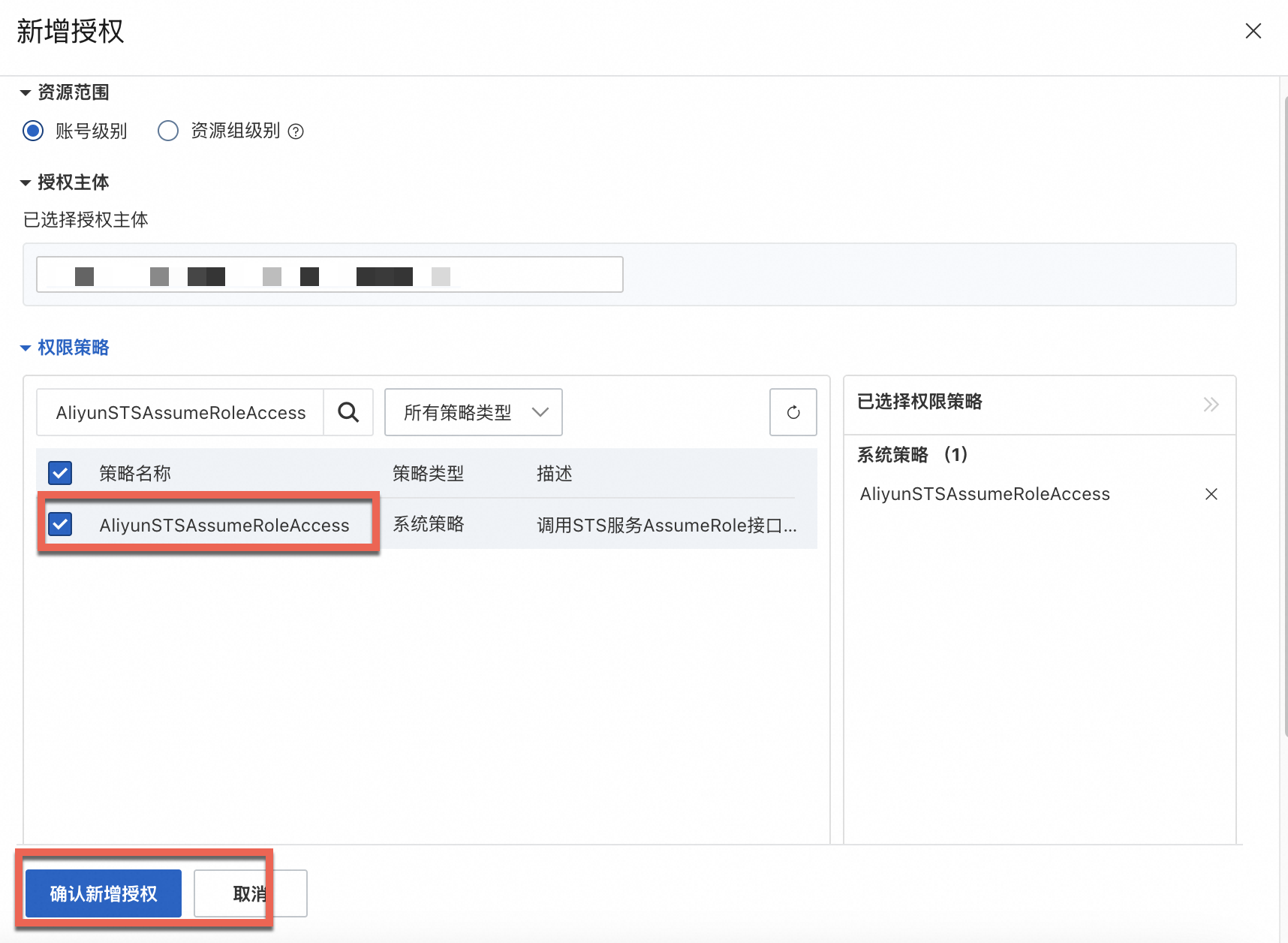
选择资源范围。
账号级别:权限在当前阿里云账号内生效。
资源组级别:权限在指定的资源组内生效。
重要指定资源组授权生效的前提是该云服务及资源类型已支持资源组,详情请参见支持资源组的云服务。资源组授权示例,请参见使用资源组限制RAM用户管理指定的ECS实例。
选择授权主体。
授权主体即需要添加权限的RAM用户。系统会自动选择当前的RAM用户。
选择权限策略。
权限策略是一组访问权限的集合,分为以下两种。支持批量选中多条权限策略。
单击确认新增授权。
单击关闭。
步骤三:创建RAM角色
下述步骤5中,建议您将角色名称设置为vodrole,本文后续描述都以角色名称vodrole为例。
使用RAM管理员登录RAM控制台。
在左侧导航栏,选择。
在角色页面,单击创建角色。
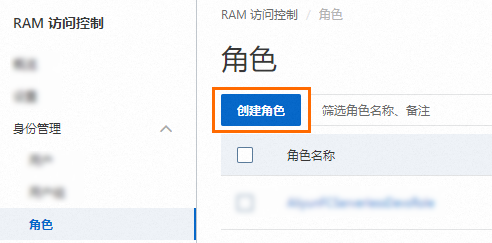
在创建角色页面,选择信任主体类型为云账号,然后设置具体的阿里云账号,最后单击确定。
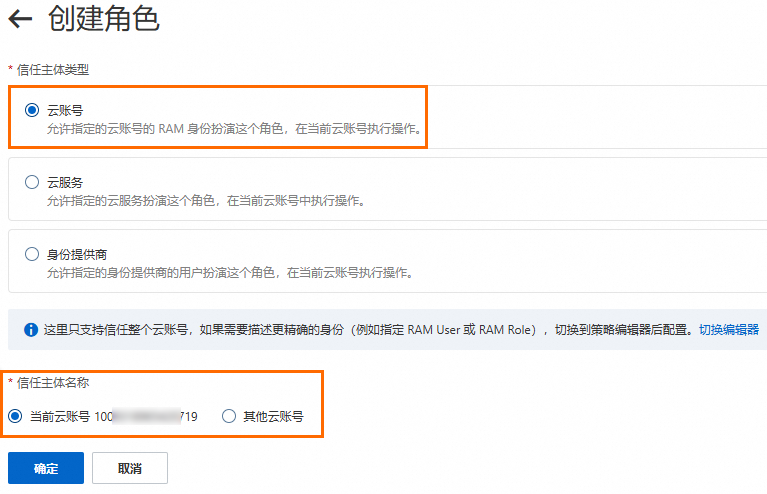
当前云账号:当您允许当前阿里云账号下的所有RAM用户和RAM角色扮演当前正在创建的RAM角色时,您可以选择当前云账号。
其他云账号:当您允许其他阿里云账号下的所有RAM用户和RAM角色扮演当前正在创建的RAM角色时,您可以选择其他云账号,然后输入其他阿里云账号(主账号)ID。该项主要针对跨阿里云账号的资源授权访问场景,相关教程,请参见跨阿里云账号的资源授权。您可以在安全设置页面查看阿里云账号(主账号)ID。
(可选)如果您想设置RAM角色只能被可信阿里云账号下的指定RAM用户或RAM角色扮演,您可以单击切换编辑器,在编辑器中修改RAM角色的信任策略。
编辑器支持可视化编辑和脚本编辑两种模式,您可以任选其一。以下示例表示当前创建的RAM角色只能被当前阿里云账号(AccountID=100******0719)下的RAM用户
Alice扮演。可视化编辑
在主体中指定具体的RAM用户名称。
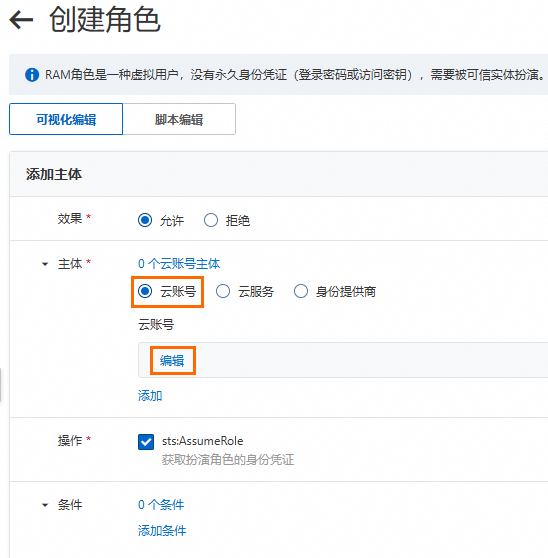
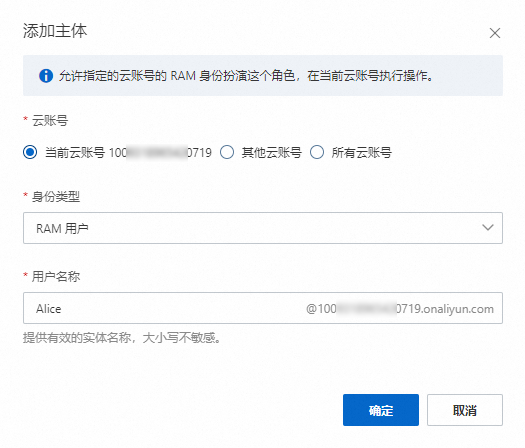
脚本编辑
在
Principal的RAM字段中指定具体的RAM用户。{ "Version": "1", "Statement": [ { "Effect": "Allow", "Principal": { "RAM": "acs:ram::100******0719:user/Alice" }, "Action": "sts:AssumeRole" } ] }
在创建角色对话框,输入角色名称,然后单击确定。
步骤四:为RAM角色授予管理VOD的权限
在RAM控制台的角色页面,单击目标RAM角色(上述创建的vodrole角色)操作列的新增授权。
在新增授权面板,为RAM角色添加权限。
说明为控制风险,建议采用最小权限。
如需vodrole角色可以访问和管理视频点播的资源,则建议为vodrole角色添加可以管理和操作视频点播所有资源的系统策略权限AliyunVODFullAccess,可通过在系统策略的搜索输入框中输入
AliyunVODFullAccess查找,更多有关视频点播系统策略的定义及权限信息请参见系统授权策略。
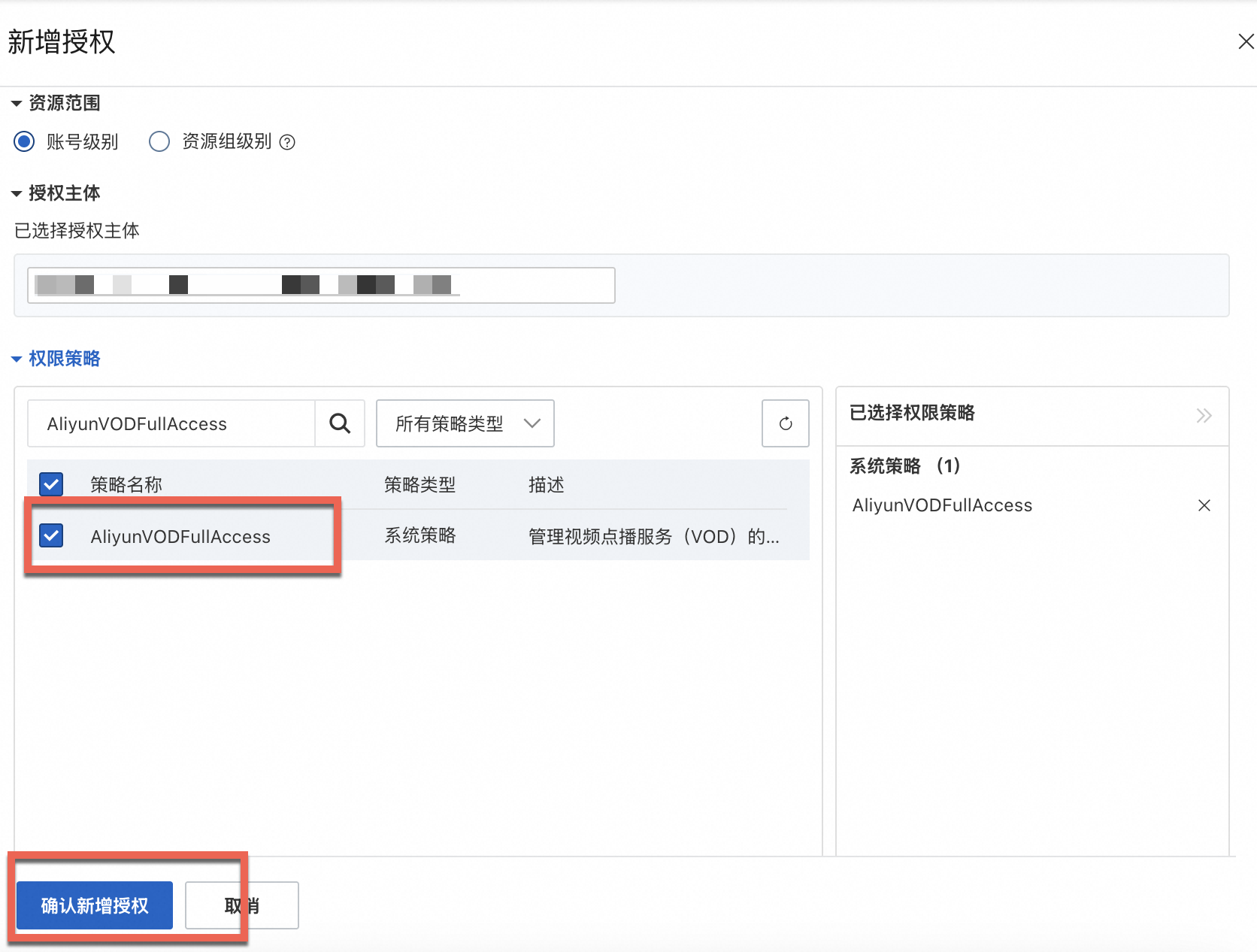
选择资源范围。
账号级别:权限在当前阿里云账号内生效。
资源组级别:权限在指定的资源组内生效。
重要指定资源组授权生效的前提是该云服务及资源类型已支持资源组,详情请参见支持资源组的云服务。资源组授权示例,请参见使用资源组限制RAM用户管理指定的ECS实例。
选择授权主体。
授权主体即需要添加权限的RAM用户。系统会自动选择当前的RAM用户。
选择权限策略。
权限策略是一组访问权限的集合,分为以下两种。支持批量选中多条权限策略。
单击确认新增授权。
完成授权后,会生成一条授权成功的记录。

单击关闭。
步骤五:扮演RAM角色并获取STS Token
使用RAM用户调用STS APIAssumeRole - 获取扮演角色的临时身份凭证获得RAM角色的安全令牌(STS Token)。您可以直接使用STS Token访问点播服务API,也可将STS Token下发到客户端完成客户端直传等操作。本文提供Java SDK示例,更多语言示例请参考STS SDK概览。
V1.0 SDK
在Maven中添加如下依赖信息:
<dependency>
<groupId>com.aliyun</groupId>
<artifactId>aliyun-java-sdk-sts</artifactId>
<version>3.1.2</version>
</dependency>
<dependency>
<groupId>com.aliyun</groupId>
<artifactId>aliyun-java-sdk-core</artifactId>
<version>4.7.3</version>
</dependency>
<dependency>
<groupId>com.aliyun</groupId>
<artifactId>aliyun-java-sdk-vod</artifactId>
<version>2.16.32</version>
</dependency>package pop;
import com.aliyuncs.DefaultAcsClient;
import com.aliyuncs.exceptions.ClientException;
import com.aliyuncs.http.MethodType;
import com.aliyuncs.profile.DefaultProfile;
import com.aliyuncs.profile.IClientProfile;
import com.aliyuncs.sts.model.v20150401.AssumeRoleRequest;
import com.aliyuncs.sts.model.v20150401.AssumeRoleResponse;
public class TestStsService {
public static void main(String[] args) {
// 从环境变量中获取步骤一生成的RAM用户的访问密钥(AccessKey ID和AccessKey Secret)。
String accessKeyId = System.getenv("ALIBABA_CLOUD_ACCESS_KEY_ID");
String accessKeySecret = System.getenv("ALIBABA_CLOUD_ACCESS_KEY_SECRET");
// AssumeRole API 请求参数:RoleArn, RoleSessionName, Policy, and DurationSeconds
// RoleArn需要通过步骤三在RAM控制台上获取
String roleArn = "<role-arn>";
// RoleSessionName 角色会话名称,自定义参数
String roleSessionName = "session-name";
// 定制你的policy
String policy = "{\n" +
" \"Version\": \"1\",\n" +
" \"Statement\": [\n" +
" {\n" +
" \"Action\": \"vod:*\",\n" +
" \"Resource\": \"*\",\n" +
" \"Effect\": \"Allow\"\n" +
" }\n" +
" ]\n" +
"}";
try {
AssumeRoleResponse response = assumeRole(accessKeyId, accessKeySecret, roleArn, roleSessionName, policy);
System.out.println("Expiration: " + response.getCredentials().getExpiration());
System.out.println("Access Key Id: " + response.getCredentials().getAccessKeyId());
System.out.println("Access Key Secret: " + response.getCredentials().getAccessKeySecret());
System.out.println("Security Token: " + response.getCredentials().getSecurityToken());
System.out.println("RequestId: " + response.getRequestId());
} catch (ClientException e) {
System.out.println("Failed to get a token.");
System.out.println("Error code: " + e.getErrCode());
System.out.println("Error message: " + e.getErrMsg());
}
}
static AssumeRoleResponse assumeRole(String accessKeyId, String accessKeySecret, String roleArn, String roleSessionName, String policy) throws ClientException {
try {
//构造default profile(参数留空,无需添加Region ID)
/*
说明:当设置SysEndpoint为sts.aliyuncs.com时,regionId可填可不填;反之,regionId必填,根据使用的服务区域填写,例如:cn-shanghai
详情参考STS各地域的Endpoint。
*/
IClientProfile profile = DefaultProfile.getProfile("", accessKeyId, accessKeySecret);
//用profile构造client
DefaultAcsClient client = new DefaultAcsClient(profile);
// 创建一个 AssumeRoleRequest 并设置请求参数
final AssumeRoleRequest request = new AssumeRoleRequest();
request.setSysEndpoint("sts.aliyuncs.com");
request.setSysMethod(MethodType.POST);
request.setRoleArn(roleArn);
request.setRoleSessionName(roleSessionName);
request.setPolicy(policy);
// 发起请求,并得到response
final AssumeRoleResponse response = client.getAcsResponse(request);
return response;
} catch (ClientException e) {
throw e;
}
}
}V2.0 SDK
在Maven中添加如下依赖信息:
<dependency>
<groupId>com.aliyun</groupId>
<artifactId>sts20150401</artifactId>
<version>1.1.7</version>
</dependency>
<dependency>
<groupId>com.aliyun</groupId>
<artifactId>vod20170321</artifactId>
<version>3.6.4</version>
</dependency>import com.aliyun.sts20150401.Client;
import com.aliyun.sts20150401.models.AssumeRoleRequest;
import com.aliyun.sts20150401.models.AssumeRoleResponse;
import com.aliyun.sts20150401.models.AssumeRoleResponseBody;
import com.aliyun.teaopenapi.models.Config;
import com.aliyun.teautil.models.RuntimeOptions;
public class TestStsService {
public static void main(String[] args) {
// 从环境变量中获取步骤一生成的RAM用户的访问密钥(AccessKey ID和AccessKey Secret)。
String accessKeyId = System.getenv("ALIBABA_CLOUD_ACCESS_KEY_ID");
String accessKeySecret = System.getenv("ALIBABA_CLOUD_ACCESS_KEY_SECRET");
// AssumeRole API 请求参数:RoleArn, RoleSessionName, Policy, and DurationSeconds
// RoleArn需要通过步骤三在RAM控制台上获取
String roleArn = "<role-arn>";
// RoleSessionName 角色会话名称,自定义参数
String roleSessionName = "session-name";
// 定制你的policy
String policy = "{\n" +
" \"Version\": \"1\",\n" +
" \"Statement\": [\n" +
" {\n" +
" \"Action\": \"vod:*\",\n" +
" \"Resource\": \"*\",\n" +
" \"Effect\": \"Allow\"\n" +
" }\n" +
" ]\n" +
"}";
try {
AssumeRoleResponse assumeRoleResponse = assumeRole(accessKeyId, accessKeySecret, roleArn, roleSessionName, policy);
System.out.println("Expiration: " + response.getCredentials().getExpiration());
System.out.println("Access Key Id: " + response.getCredentials().getAccessKeyId());
System.out.println("Access Key Secret: " + response.getCredentials().getAccessKeySecret());
System.out.println("Security Token: " + response.getCredentials().getSecurityToken());
System.out.println("RequestId: " + response.getRequestId());
} catch (Exception e) {
throw new RuntimeException(e);
}
}
public static AssumeRoleResponse assumeRole(String accessKeyId, String accessKeySecret, String roleArn, String roleSessionName, String policy) throws Exception {
Config config = new Config()
// 从环境变量中获取AccessKey ID的值
.setAccessKeyId(accessKeyId)
// 从环境变量中获取AccessKey Secret的值
.setAccessKeySecret(accessKeySecret);
config.endpoint = "sts.cn-hangzhou.aliyuncs.com";
Client client = new Client(config);
AssumeRoleRequest assumeRoleRequest = new AssumeRoleRequest()
.setRoleArn(roleArn)
.setRoleSessionName(roleSessionName)
.setPolicy(policy);
RuntimeOptions runtime = new RuntimeOptions();
return client.assumeRoleWithOptions(assumeRoleRequest, runtime);
}
}